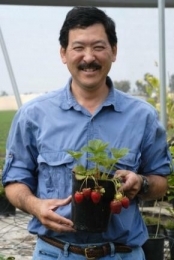
Name
Steven Koike
Title
Plant Pathology Farm Advisor
Institution
University of California Cooperative Extension, Monterey County
Education
1980: M.S., University of California, Davis, Plant Protection & Pest Management
1978: B.S., University of California, Davis, Plant Science/Plant Pathology
What brought you to the UC Cooperative Extension in Monterey County?
My university training focused on plant pathology, so I was interested in a Farm Advisor position that would allow me to work primarily in this field. Monterey County had, and still has, one of the few county-based positions dedicated to plant pathology. Also, I had experience working with cool-season vegetables and strawberries, and hoped to continue to work with these commodities in the Salinas Valley.
How did you learn about the Center for Produce Safety?
Food safety issues have long been a concern for leafy green vegetable growers in central coast California. Because the recent (2006) E. coli outbreak involved spinach grown in our region, I followed the development of industry and university efforts to address these concerns. CPS was one of the collaborative efforts that caught my attention.
So why did you apply for funding from CPS?
With my background in plant pathology, I assembled a county-based laboratory that could assist me in research and education in this field. This laboratory is one of few such UC facilities at the county level in California. When the food safety issues escalated, I believed that my laboratory could be further equipped and expanded to conduct applied field studies involving food safety subjects. I also had the opportunity to team up with campus-based researchers (Trevor Suslow and Linda Harris) who could add to the strength of our research projects. Because of these factors, I wanted to expand my extension program to include food safety issues, and looked to CPS to help fund a project.
CPS recently awarded funding to your project " Examination of the survival and internalization of E.Coli on spinach under field production environments.” What do you think the industry will gain from your research?
I believe our major contribution is the field-oriented research that we conduct. We have the benefit of a very advanced industry that recognizes the value of research and is willing to support and host research. We are therefore able to conduct research under real-world, field conditions. We hope that we and the industry can learn about the dynamics and ecology of enteric bacteria as they occur in the field.
What do you think are the key factors influencing this field of inquiry?
First is the interest and collaboration between researchers and industry: with great cooperation, we can get a lot done. Also, the continuing advances in technology: there are many tools available now for detecting and working with food borne pathogens and hopefully more tools will be developed. Third, education: research findings need to update the industry and inform consumers.
The big question though is where do you see the field of food safety research ten years down the road?
Food Safety is by no means is a new thing. The issue has existed for a very long time. I feel that in ten years due to continuing research we will still see new tools, better techniques, and improvements in detection and management of foodborne pathogens. We will get better at being more precise in working with such problems, and the industry will continue to improve its food safety systems, though most researchers believe there is no such thing as “zero risk.” I also hope to see more collaboration. We are partnered right now through CPS with the UC Davis team, and the industry in Salinas has encouraged and supported our team. I feel it is a good model, and hope in years to come we can partner with other universities and organizations as we improve food safety.
When you aren’t putting in hours in your field of work, how else do you spend your time?
I work in the laboratory about 10% of the time, because in Extension we are extremely field oriented, whether in the greenhouse or out in growers’ fields. I would say I spend about 40% of the time outdoors not only in spinach fields, but other vegetable crops and strawberries as well. A significant amount of time is spent with growers, either discussing their production concerns or working on their samples submitted for diagnosis. Outside of working, I’m married with two sons (for the first time both are away at college). I enjoy reading and classical music, and I also coach basketball; I like the teaching aspect of coaching at younger levels—middle school/freshman boys or girls.
Finally, what would you consider one or more of your career highlights?
In 2007, I published a book on plant pathology (Koike, S. T., Gladders, P., and Paulus, A. O. 2007. A Color Handbook of Diseases of Vegetables. Manson Publishing. London). It was a huge project, but extremely worth while to put in one place the many things I’ve seen and learned about. The book was intended to be very practical for an applied audience, and I feel we did a very good job, and that the industry uses it. I was also a recipient in 2005 of a research and teaching endowment named after my plant pathology professor and mentor, the late Dr. Joseph M. Ogawa, and a recipient in 2002 of a University of California ANR Distinguished Service Award for Outstanding Research.